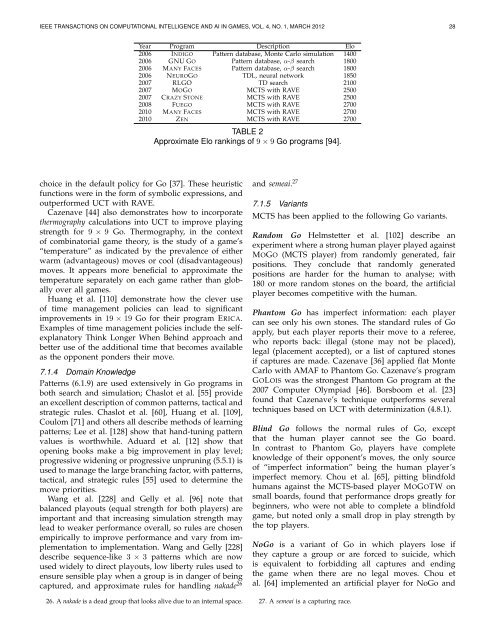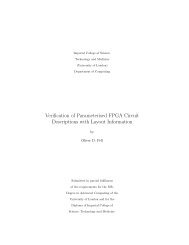A Survey of Monte Carlo Tree Search Methods - Department of ...
A Survey of Monte Carlo Tree Search Methods - Department of ...
A Survey of Monte Carlo Tree Search Methods - Department of ...
You also want an ePaper? Increase the reach of your titles
YUMPU automatically turns print PDFs into web optimized ePapers that Google loves.
IEEE TRANSACTIONS ON COMPUTATIONAL INTELLIGENCE AND AI IN GAMES, VOL. 4, NO. 1, MARCH 2012 28<br />
Year Program Description Elo<br />
2006 INDIGO Pattern database, <strong>Monte</strong> <strong>Carlo</strong> simulation 1400<br />
2006 GNU GO Pattern database, α-β search 1800<br />
2006 MANY FACES Pattern database, α-β search 1800<br />
2006 NEUROGO TDL, neural network 1850<br />
2007 RLGO TD search 2100<br />
2007 MOGO MCTS with RAVE 2500<br />
2007 CRAZY STONE MCTS with RAVE 2500<br />
2008 FUEGO MCTS with RAVE 2700<br />
2010 MANY FACES MCTS with RAVE 2700<br />
2010 ZEN MCTS with RAVE 2700<br />
choice in the default policy for Go [37]. These heuristic<br />
functions were in the form <strong>of</strong> symbolic expressions, and<br />
outperformed UCT with RAVE.<br />
Cazenave [44] also demonstrates how to incorporate<br />
thermography calculations into UCT to improve playing<br />
strength for 9 × 9 Go. Thermography, in the context<br />
<strong>of</strong> combinatorial game theory, is the study <strong>of</strong> a game’s<br />
“temperature” as indicated by the prevalence <strong>of</strong> either<br />
warm (advantageous) moves or cool (disadvantageous)<br />
moves. It appears more beneficial to approximate the<br />
temperature separately on each game rather than globally<br />
over all games.<br />
Huang et al. [110] demonstrate how the clever use<br />
<strong>of</strong> time management policies can lead to significant<br />
improvements in 19 × 19 Go for their program ERICA.<br />
Examples <strong>of</strong> time management policies include the selfexplanatory<br />
Think Longer When Behind approach and<br />
better use <strong>of</strong> the additional time that becomes available<br />
as the opponent ponders their move.<br />
7.1.4 Domain Knowledge<br />
Patterns (6.1.9) are used extensively in Go programs in<br />
both search and simulation; Chaslot et al. [55] provide<br />
an excellent description <strong>of</strong> common patterns, tactical and<br />
strategic rules. Chaslot et al. [60], Huang et al. [109],<br />
Coulom [71] and others all describe methods <strong>of</strong> learning<br />
patterns; Lee et al. [128] show that hand-tuning pattern<br />
values is worthwhile. Aduard et al. [12] show that<br />
opening books make a big improvement in play level;<br />
progressive widening or progressive unpruning (5.5.1) is<br />
used to manage the large branching factor, with patterns,<br />
tactical, and strategic rules [55] used to determine the<br />
move priorities.<br />
Wang et al. [228] and Gelly et al. [96] note that<br />
balanced playouts (equal strength for both players) are<br />
important and that increasing simulation strength may<br />
lead to weaker performance overall, so rules are chosen<br />
empirically to improve performance and vary from implementation<br />
to implementation. Wang and Gelly [228]<br />
describe sequence-like 3 × 3 patterns which are now<br />
used widely to direct playouts, low liberty rules used to<br />
ensure sensible play when a group is in danger <strong>of</strong> being<br />
captured, and approximate rules for handling nakade 26<br />
26. A nakade is a dead group that looks alive due to an internal space.<br />
TABLE 2<br />
Approximate Elo rankings <strong>of</strong> 9 × 9 Go programs [94].<br />
and semeai. 27<br />
7.1.5 Variants<br />
MCTS has been applied to the following Go variants.<br />
Random Go Helmstetter et al. [102] describe an<br />
experiment where a strong human player played against<br />
MOGO (MCTS player) from randomly generated, fair<br />
positions. They conclude that randomly generated<br />
positions are harder for the human to analyse; with<br />
180 or more random stones on the board, the artificial<br />
player becomes competitive with the human.<br />
Phantom Go has imperfect information: each player<br />
can see only his own stones. The standard rules <strong>of</strong> Go<br />
apply, but each player reports their move to a referee,<br />
who reports back: illegal (stone may not be placed),<br />
legal (placement accepted), or a list <strong>of</strong> captured stones<br />
if captures are made. Cazenave [36] applied flat <strong>Monte</strong><br />
<strong>Carlo</strong> with AMAF to Phantom Go. Cazenave’s program<br />
GOLOIS was the strongest Phantom Go program at the<br />
2007 Computer Olympiad [46]. Borsboom et al. [23]<br />
found that Cazenave’s technique outperforms several<br />
techniques based on UCT with determinization (4.8.1).<br />
Blind Go follows the normal rules <strong>of</strong> Go, except<br />
that the human player cannot see the Go board.<br />
In contrast to Phantom Go, players have complete<br />
knowledge <strong>of</strong> their opponent’s moves, the only source<br />
<strong>of</strong> “imperfect information” being the human player’s<br />
imperfect memory. Chou et al. [65], pitting blindfold<br />
humans against the MCTS-based player MOGOTW on<br />
small boards, found that performance drops greatly for<br />
beginners, who were not able to complete a blindfold<br />
game, but noted only a small drop in play strength by<br />
the top players.<br />
NoGo is a variant <strong>of</strong> Go in which players lose if<br />
they capture a group or are forced to suicide, which<br />
is equivalent to forbidding all captures and ending<br />
the game when there are no legal moves. Chou et<br />
al. [64] implemented an artificial player for NoGo and<br />
27. A semeai is a capturing race.















